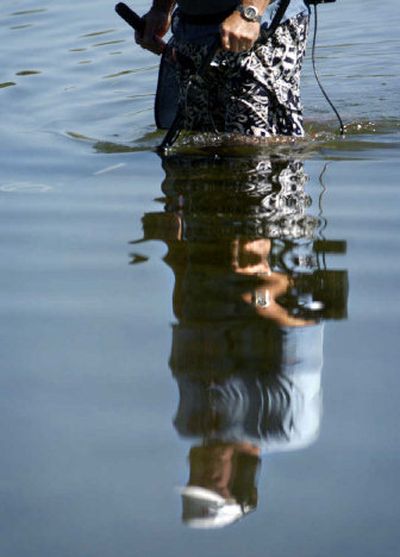METAL HEADS

Forget what Mom says. Sometimes, it’s OK to play in the dirt.
Steve Burris of Post Falls has been doing it for 25 years and on a trip to Alaska last June, he unearthed a treasure.
It was the second weeklong trip Burris had made to Clark-Wiltz Mining, an 18-square-mile plot of land at Ganes Creek, Alaska, where metal-detecting junkies pay to hunt for the uncovered remnants of heavy prospecting done by miners in the area 70 years ago.
Spring runoff had uncovered a lot of big rocks. One gray mud-covered stone made Burris’ Goldbug 2 gold detector signal loudly.
“There’d been a lot of people in there,” he says. “They might have thought it was a big piece of junk or something. When I lifted it up and grabbed a hold of it, I knew it was gold. It was pretty heavy.”
Just under 34 ounces, actually. Burris had picked up the largest known gold nugget found by a noncommercial miner in Alaska.
“I couldn’t believe it,” he says. “That thing was right on top of the ground.”
This winter, Burris traded the heart-shaped nugget measuring about 4 inches across and 2 inches thick back to Clark-Wiltz Mining for gold coins and a free trip there next summer.
Like most treasure hunters, Burris keeps his finds in a safety deposit box at a bank.
Not all metal detecting expeditions are as successful. But Burris is just one of hundreds of people in the Inland Northwest who face the elements with detectors in their hands and headphones over their ears looking for treasure.
It might seem like a strange way to pass the time. But for Lucile Bowen it’s therapeutic.
“I just love to break my fingernails and dig,” says Bowen, 80. “It’s a sense of gambling, you don’t know what you’re going to get.”
Bowen was a charter member of the Northwest Treasure Hunters Club and the original owner of Bowen’s Hideout – the favorite shopping location for any local treasure hunter.
On patrol as a police officer in Spokane about 40 years ago, Bowen’s husband, Harry, stopped to talk to a man who had a cigar box full of Indian head pennies and coins he’d found metal detecting.
“That’s all it took for Harry,” Bowen says.
That’s about all it took for Dick Turner, too. He got started 15 years ago after watching a fellow detectorist turn up a bucket of silver coins in the yard of Turner’s 1904 Reardan home.
He traded in the tools of his former hobbies - radio-controlled cars and golf – for a metal detector.
Turner bought Bowen’s Hideout in 2000 and moved it from the Bowens’ basement to a tiny Sprague Avenue shop where a 2-square-foot display table shows some of his treasures. Inside a circle of rings are a few antique toy cars, some knives and pins and a brass hand bail he found in some dirt removed from Manito Park that turned out to match an old sword a friend found the next day.
These are his favorites. He sells most of his finds.
“It’s the only hobby that I’ve ever had that’s had a return,” Turner says. “When you get done at the end of the day, you should have enough money to buy you a coke or something. Or a hamburger. Or batteries.”
Those can come in handy. While the novice can start out with nothing but a metal detector and a pocket, seasoned hunters don’t leave home without a scoop for water hunting, headphones, chest waders, a wet suit, small probes, a trowel, a mini detector and a treasure pouch or apron.
The least expensive detector Turner sells is White’s Prism II for $199. The most expensive is a Minelab for $3,995, designed for desert gold hunting.
“That’s for the serious Joe,” Turner says. “I’m not that serious.”
The least expensive model identifies a coin, indicates what kind it is and zeros in on its location. They increase in price with extra features, like depth finders or how well they find gold.
Of course, what you find depends on where you look.
“It’s getting tougher to find good sites, so a guy’s got to spend a little time in the library,” Turner says.
Anywhere people have gathered, metal detectors are likely to sing, Bowen says. But new hunters are cautioned never to leave holes and always to get permission.
Popular sites include schools, beaches, construction zones and for the boldest of hunters, outhouses.
Finding indentations where old privies once were anchored, some detectorists probe the ground to see what’s at the bottom. Finds range from coins to bottles to a 14-piece set of silver flatware an acquaintance of Turner’s found.
Turner has never done it. But his father-in-law has three old outhouses on his property that have often tempted Turner to become a privy digger.
“I think about it every now and then,” he says.
But some treasures are better left unfound.